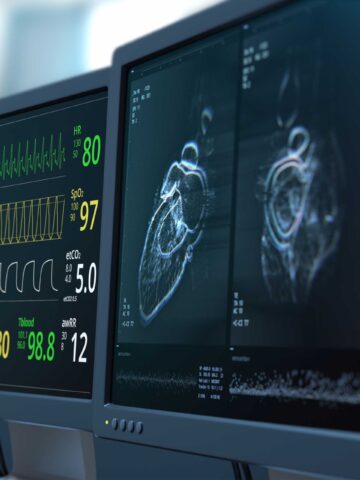A CHOC physician is curing patients of chronic irregular heart beats by using an electrophysiology outpatient procedure that requires no radiation, a landmark achievement that signals a new direction in the field.
Safer and more accurate for young heart patients, the successful radiation-free electrophysiology procedure is credited to the skill and expertise of Dr. Anjan Batra, medical director of electrophysiology at the CHOC Heart Institute, as well as the state-of-the-art cardio mapping equipment inside CHOC Hospital in Orange.
“This has really changed our field,” Dr. Batra said. “We can do so much more, and do it better and safer. It’s great to be in a field where we cannot just treat, but also cure. It’s great to help a patient so that they don’t have to see a doctor for the condition again.”
Three-dimensional maps of the heart
Dr. Batra performed the procedure using the CARTO 3 system, a three-dimensional cardio mapping system manufactured by Biosense Webster. The device uses catheters with locator sensors that transmit signals from inside the heart. This allowed Dr. Batra to visualize the beating heart by using these magnetic sources as reference points, rather than relying on fluoroscopy — an imaging technique that uses X-rays to obtain images of internal organs while they’re in motion — to reveal the catheters’ positions.
The result is a three-dimensional map of the heart that depicts the anatomy of the heart chamber, as well as how the electrical current flows in the chamber. This picture allows Dr. Batra to localize the patient’s abnormal current flow, mark it, and ablate it without using radiation that could potentially harm the patient as well as staff.
In the above video, the flow of electricity within the heart is shown as a red wave. Catheters can be seen floating within the heart. Areas of normal conduction are marked with a yellow dot, and areas with abnormal conduction are marked with red dots. Ablation at the red dots usually leads to successful elimination of the abnormal electrical cells.
In the above image, the flow of electricity within the heart is depicted in color from early (red) to late (purple). Catheters can be seen floating within the heart. Areas of normal conduction are marked with a yellow dot, and areas with abnormal conduction are marked with red dots. Ablation at the red dots usually leads to successful elimination of the abnormal electrical cells.
Revolutionary radiation-free procedures for kids
A radiation-free electrophysiology procedure is the latest revolution in a field that has already dramatically changed cardiology. The ability to perform fluoroless ablations could broaden the candidate pool for this life-changing procedure. For example, patients who recently underwent chest radiation could become candidates.
Also, because the map indicates ablation points, a surgeon could easily return to the spot should another episode occur. Further, the technique could present cost savings as it requires fewer catheters.
About 25 years ago, the only cure for these conditions was open heart surgery, and many patients simply tolerated the condition or relied on medication.
Today, the CHOC Electrophysiology Program is one of the largest regional programs of its kind, with experts performing more than 100 pediatric electrophysiological procedures each year, and eliminating 95 percent of arrhythmias from the upper chambers of the heart.

CHOC Hospital was named one of the nation’s best children’s hospitals by U.S. News & World Report in its 2024-25 Best Children’s Hospitals rankings and ranked in the cardiology specialty.




